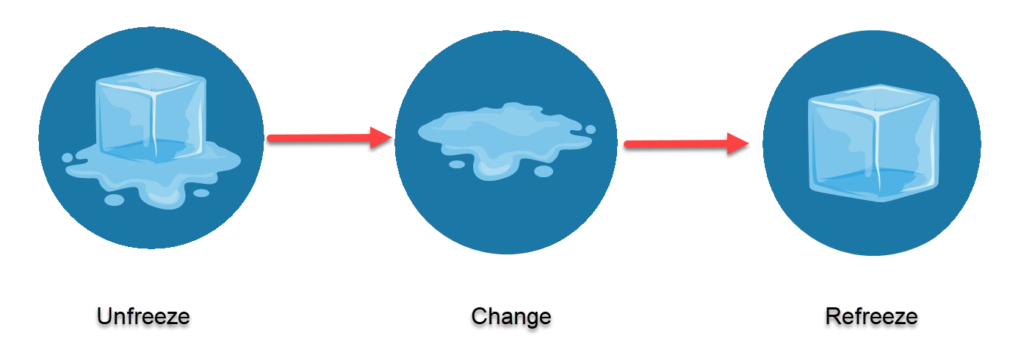Understanding the 3 Stages of Change
In my last two blog entries, I described change resistance and ways to turn it around; and John P Kotter’s lead & accelerate model. Now that we clearly understand that change is a common binding thread across all organisations, regardless of its size, nature, age, and industry. An organisation must evolve and change faster to meet the new market expectation and demands or risk extinction. Nokia, Blockbuster, PAN AM, Toys R Us, Compaq, and Blackberry were once phenomenally successful organisations that forgot to innovate, evolve, and thus lost to the test of time. In the current world, only the organisation that can handle change will survive and thrive. In my current post, I will discuss Kurt Lewin’s three stages of the change management model and how to apply this simple yet effective model to your organisation.

Most organisations today are familiar with the term “change management“; however, the degree of success varies depending on the nature of the business, people involved, leadership commitment and priorities, etc. Today I will discuss one of the earliest models of change management coined by Kurt Lewin, a German American psychologist who is considered the father of social psychology. In the year 1940, Kurt theorized a 3-stage model, “unfreezing-change-refreeze”, that requires prior learning to be rejected and replaced. although the model is simplistic, its core idea is still relevant in today’s modern disruptive world.
Kurt Lewin’s Change Management Model
Kurt Lewin, a physicist and a social scientist explained a three-stage change process as “Unfreeze –> Change –> Refreeze” using the analogy of changing the shape of a block of ice. Lewin’s Change Management Model framework is both simple & easy to understand for managing change.
So how to transform an ice cube into an ice cone?
Stages of Change: Unfreeze –> Change –> Refreeze
Consider you have an ice cube, and you wish to transform/change it into an ice cone. Kurt used physicist knowledge and drew a parallel analogy to explain the change in an organisational context. He theorised one must melt the ice first to make it amenable to change (unfreeze) and then mould the iced water into the shape you want (change). Finally, it would be best if you solidified the new form (refreeze).

Lewin’s Change Model, AKA Unfreeze, Change, Refreeze, suggested perceiving the change as a three distinct process stage. It asks to prepare yourself & the organisation for the upcoming change and make and validate the plan to manage the change/transformation. He argued unpreparedness and surprises often cause much unnecessary turmoil, chaos, and setbacks.
For any successful change to occur, one must first start by understanding why the change must occur and re-examine cherished assumptions. During the unfreezing stage, ensure to generate motivation for successful change & transition to transpire.
Unfreeze – Determine what needs to change
This first stage of change requires preparing the organisation for breaking down the existing status quo, recognising that change and a new way of operating are needed.
The key to this is developing a compelling message showing why the existing way of doing things cannot continue. Deep data analytics, AI, Machine learnings and statistics are your friends; use these tools to your advantage to highlight poor financial results, declining sales figures, poor customer satisfaction, or suchlike. Show & demonstrate things must change in a way that everyone can understand.
To prepare & set the organisation for a successful change, challenge its current core beliefs, values, and behaviours. Like a building structure, carefully examine its foundations, and be well-prepared to amend, replace or even start again if you wish to have a stable building structure or risk collapse.
This stage of the change process is usually the most challenging and stressful, and you may have to make many tough and unpopular decisions. Cutting down on the “way things are done here” puts everyone and everything off balance. You may evoke some adverse reactions and criticism on the way. Create a controlled crisis by forcing the organisation to introspect & retrospect its core beliefs, which will build a desire & motivation to seek a new equilibrium. This newfound motivation, buy-in and participation are of utmost necessity to effect any meaningful change.
However, be careful as change does not always impact everyone equally; and it’s your responsibility to manage:
- Those negatively impacted by the change will offer active resistance to change. This category of people may fear a loss of power, position, authority, and suchlike.
- Some stakeholders would like to hijack, piggyback, and even derail the change effort to benefit and fulfil their agenda. They offer passive resistance to the change and are dangerous to change objectives. This category of people includes those who will appear supportive from outside and may inadvertently harm the efforts by skewing resources and goals.
- Finally, those onboard to the change effort genuinely support the change and advocate for others to follow. This category of people will help you accelerate and find momentum.
Use your change & people management skills to deal with change resistance. Minimise friction by upskilling, imparting training, communicating effectively, providing assurances, showing urgency, and what value they may gain by letting go of their fears.
Remember, not everyone will support the change because it benefits the broader organisation.
Time & communication are the two keys to the change occurring successfully. Provide people with enough information about the upcoming change to understand and appreciate the transformation efforts and feel connected. Change usually requires a lot of time, effort, and endurance; make sure you and the organisation are well prepared.
Unfreeze recap
Start with an in-depth examination organisation to clearly understand the current state and why “change” must occur. Win the support of key stakeholders, gather fanatical support from senior management, and buy in from the leadership team within the organisation. Use vision and strategy to create a compelling message, and communicate across the organisation.
Show them the urgency to change, emphasising the “why.” Listen to the voices of people, their doubts & concerns, remain open and address those concerns, and steer and align them towards the change.
Change – Mould
Tension and crisis created in the unfreeze stage uplift the desire to resolve uncertainty. Promote innovation, a new way of doing, working, and looking at things. The unfreeze-to-change transition does not happen overnight. It takes time for people to align with the new direction, embrace the change transition and participate both positively & proactively. People need to see the opportunity – how it may help the organisation and them. And also how your vision, strategy, and change drive will help the organisation and themselves succeed before they support/contribute. Change becomes easier once people start to believe, appreciate, and support the new direction.
Change Recap
Describe the benefits of change, use all channels to communicate effectively, and paint a visual picture. Describe and explain – how the changes will affect people and prepare them for what is coming. Use effective communication to dispel the rumours and answer questions and concerns openly and honestly. Empower action, involve people in the process, provide involvement opportunities, and deal with problems immediately. Generate and celebrate short-term wins to reinforce the change.
Refreeze – Anchor the changes into the culture
Even though change is a constant, final stage refreezing is particularly important. In the absence of the refreeze or anchor state, the organisation may end up in a never-ending "change trap" loop.
And it will be challenging to effectively tackle the next change initiative without a new frozen state. You won’t convince people of a new change unless you have allowed the most recent change to sink in. People will lack the motivation to implement and onboard another new change.
The organisation is ready to refreeze when people have embraced the new ways of working and changes are taking shape. A stable organisation chart and consistent job descriptions and suchlike are key outward signs of the refreeze. In the refreeze stage, help people and the organisation internalise or institutionalise the changes. Ensure to use changes all the time and incorporate them into everyday business. Employees will feel more confident and comfortable with the new ways of working & a new sense of stability.
As part of the anchoring and refreezing process, make sure to celebrate the success of the change. Sincerely thank the people involved for their help and support in the journey and for enduring a painful time during the transition. Help them find closure and take pride in being part of a successful change.
Refreeze Recap
Identify what supports the change, what barriers are to maintaining the change, and how to sustain the change. Provide training and support, and establish a feedback & reward system. Adapt & adjust the organisation structure where necessary.
Intelligence is the ability to adapt to change.
Stephen Hawking
